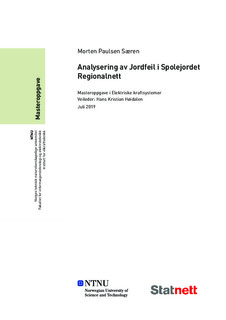Jordfeil i Spolejordet Regionalnett.
| dc.contributor.advisor | Høidalen, Hans Kristian | |
| dc.contributor.author | Særen, Morten Paulsen | |
| dc.date.accessioned | 2019-11-16T15:01:51Z | |
| dc.date.available | 2019-11-16T15:01:51Z | |
| dc.date.issued | 2019 | |
| dc.identifier.uri | http://hdl.handle.net/11250/2628804 | |
| dc.description.abstract | En forenklet modell av Nordnettet er etablert i programvaren ATP Draw. Modellen er designet for å analysere jordfeilstrømmer, spenning og resonanskurve. Den er bygd opp slik at man selv kan stille inn spoleinnstillingene etter ønske. Modellen fungerer til sitt formål og man kan legge på konduktiv avledning. Modellen kan kjøre transiente grafiske analyser av både feilstrøm i spoler og feilsted. Feilstrømmen er blitt presenter for feil i alle regionene. På bakgrunn av disse feilene er det blitt sett på hvordan feilstrømmen oppfører seg. Det er også sett på spolenes egenskaper før og etter feil. Det er observert at spolene bruker lengre tid på å stabilisere spolebidraget for feil langt unna. I tillegg vil den transiente responsen ha høy amplitude. Den høye amplituden er avgjørende for hvordan feilstrømmens utforming blir. Har man høyt spolebidrag i et område vil feilstrømmen i feil langt unna dette område få lavt makspunkt på impulsresponsen. Til gjengeld bruker også disse feilene lengre tid på å nå ønsket feilstrøm. I alle feilsituasjonene simulert vil feilstrømmen i modellen kompenseres ned til et ønsket nivå. Det er ikke noen forskjell på hvor feilen er lokalisert. Strømmene i spolene nærmest feilen vil ha minst svingninger og stabilisere seg raskest for å gi bidrag. Når feilen er i et område med høy spoleytelse vil feilen raskt bli kompensert ned til ønsket nivå. Størrelsene på spolene vil være avgjørende for hvilken kurve man ønsker på feilstrømmen. Det er ikke avgjørende med utformingen på kurven til feilstrømmen, da denne strømmen vil kompenseres ned i alle feilstedene i nettet I feilstedet vil feilfasen ha null spenning mens de to friske fasene får en spenningsheving på√3. Ser man på ende til ende spenningen så vil feilfasen etablere en liten spenning, mens de to andre fasene fortsetter med en lik spenningsheving på ca. √3. Det kan tyde på at konduktans bidrar med å øke feilstrømmen med en reel del i feilstrømmen. Det er absoluttverdien på den komplekse strømmen som avgjør hvor stor feilstrømmen blir. Spoleinnstillingen kan være korrekt, men med økt reel del vil det ikke være mulig å oppnå ønsket verdi på feilstrømmen. Det ble gjort funn av skjevfordelte faser der feilfasen fikk forhøyet spenningsnivå og den ene friske fasen fikk et minsket nivå. | |
| dc.description.abstract | A simple model of Nordnettet is established by using the software ATP Draw. The model is designed to analyze eurth fault currents, voltages and the resonance curve. It is designed in a way that makes it easy to set the compensation current as you want. The model works by the means of its use and you can add conductance to analyze the resonance curve. The model can provide transient graphical analyzes of the fault current in petersons coils and for the fault location. The fault current is presented from fault located in all the regions of the network. Based on these faults it is studied how the current behaves. The petersons coil characteristics is also studied before and after a fault occurs. It is observed that the coil uses longer time to stabilize the current contribution for faults located far away. In addition, the transient response will have a high amplitude witch will be decisive for the fault currents curve. If there is a big amount of current contribution from coils in a region, the fault current in faults that are far away from this region, will have a low maksimum point in the impulse response. In return, these faults will take longer time to compensate. In all of the faulty situations simulated the current gets compensated to the required level. The location of the fault will not affect the compensation. The current in the closest coils, with respect to the fault, will have less fluctuations and will stabilize fastest to compensate. When the fault is in a region with a big amount of current contribution from the coils, the fault current will get compensated quickly. The size of the coils will be decisive on how the curve of the fault current is. The design of the fault current is not decisive for the compensation since all the faults were compensated to the required level. In the fault location, the faulty feeder will have zero voltage while the other phases gets a voltage increase of √3.If you lokk on the end to end voltage, the faulty feeder will have a small voltage, while the other two healthy feeders continues to have a voltage increase of √3. It may indicate that conductance contributes to increase the fault current by adding a real component to the complex current. It is the absolute value of the complex current that decides on how big the current will get. The settings of the coil contribution of the system can be used, but by increasing the real part of the current, it will not be possible to achive the required level of the fault current. Findings of skewed distribution of voltage by the means that the faulty feeder got an increase of the voltage, while one of the healthy feeders got reduced voltage, | |
| dc.language | nob | |
| dc.publisher | NTNU | |
| dc.title | Jordfeil i Spolejordet Regionalnett. | |
| dc.type | Master thesis |
Tilhørende fil(er)
Denne innførselen finnes i følgende samling(er)
-
Institutt for elkraftteknikk [2443]
